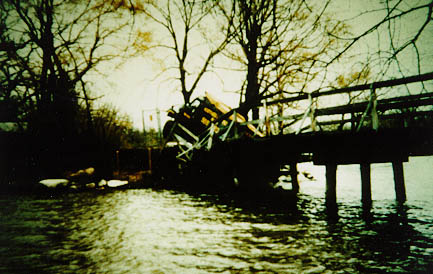by
Charles C. Roberts, Jr.

There are many private bridges owned by insured's throughout the country. The maintenance
of these bridges is typically the responsibility of the insured. From time to time, a vehicle
traveling over the bridge will cause a collapse of the bridge, damage to the vehicle and possible
personal injury. The owner of the bridge, the insured, is often accused of negligent maintenance
of the structure. This may or may not be true. Factors regarding the loss that tend to implicate
the insured are:
1. Deterioration of the wood bridge structure
2. Improper design of the bridge structure
3. Improper construction
Deterioration of the wood structure can be easily observed from failed wood members
(see Claims, March 1991, Wood Failure Analysis). Dry rot, insect attack, and other decay
related failure modes signal the weakening of the structure. Improper design can be assessed
by looking at plans and determining the load capacity of the structure by calculation.
Improper material selection such as not specifying treated wood at specific locations
may be a design deficiency. Finally, improper construction, such as failure to install
members or bolts can sufficiently weaken a structure.
The mere failure of a bridge, where the claimant gets "dumped in the creek" is not
usually persuasive in assigning liability to the insured. Some examples of factors
implicating claimants are:
1. Operating an overloaded vehicle
2. Impacting the structure causing failure
3. Traveling at a speed such that dynamic forces overload the structure

FIGURE 1

FIGURE 2
Overloading a construction vehicle to save trips to the rock quarry is not unheard of.
Vehicular impact with a bridge structural member can cause failure. Dynamic forces,
those caused by bouncing or swaying, can superimpose additional loads on the bridge,
causing a failure. Figure 1 is a view of a large truck that attempted to back over a private
bridge to dump a load of gravel. Immediately, when the rear dual axles of the truck were
supported by the bridge, a collapse occurred, trapping the truck on the bridge. The truck
was recovered and the bridge analyzed. Figure 2 shows a wood beam that had failed in
a rotted area. The loss scenario is a classic failure to maintain.

FIGURE 3

FIGURE 4
Figures 3 and 4 are views of a private suspension footbridge over a small creek. The
insured was in the habit of letting snowmobilers drive their sleds over the bridge between
farm fields. While crossing the bridge, a sled and driver fell through the bridge into the
creek. Failure analysis of the wood stringers showed a degree of rot, reducing the load
carrying capacity. However, the bouncing of the snowmobile as it crossed the wood
stringers added dynamic loading to the system resulting in the loss. Here a combination
of wood rot and dynamic loading explains the failure.
When analyzing bridge failures, structural analysis of the bridge aids in the determination
of load capacity. Computing or measuring the vehicle load determines the safety margin
of the system, i.e., the difference between the bridge load capacity and the load carried.
Finally, investigating deterioration, construction and design peculiarities further refines
the cause of failure.
FOR TECHNICAL ARTICLES CONTACT CLAIMS MAGAZINE AND ASK
FOR A REPRINT OF A PAST TECHNICAL NOTEBOOK ARTICLE
CLAIMS MAGAZINE
BACK TO C. ROBERTS CONSULTING ENGINEERS HOME PAGE,
WWW.CROBERTS.COM

FIGURE 1

FIGURE 2

FIGURE 3

FIGURE 4
FOR TECHNICAL ARTICLES CONTACT CLAIMS MAGAZINE AND ASK
FOR A REPRINT OF A PAST TECHNICAL NOTEBOOK ARTICLE
CLAIMS MAGAZINEWWW.CROBERTS.COM